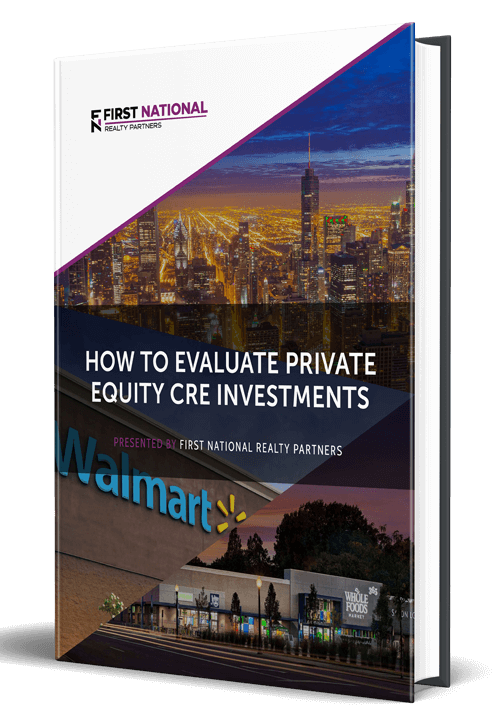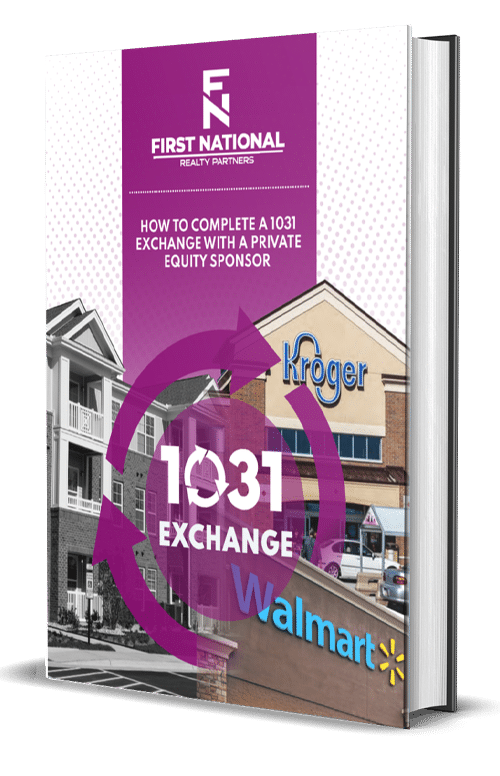An Investor’s Guide to the 95% Rule in 1031 Exchanges
A 1031 Exchange is a strategy used by real estate investors and real estate agents to defer capital gains taxes by “swapping” one investment property for another. The term gets its name from the IRS Internal Revenue Code – IRC section 1031 and the use of this strategy is one of the major potential benefits of a commercial real estate investment.
In this article, we are going to discuss 1031 Exchanges and one of the major rules that must be followed when completing one – the 95% rule. We will describe what it is, how it works, and why it is important to understand it to best position your real estate investment strategy for this important tax deferral benefit. By the end, readers will have all the information needed to determine if the 95% Rule is a good fit for their investment strategy.
First National Realty Partners is a private equity commercial real estate investment firm that specializes in the purchase and management of grocery store anchored retail centers. If you are an accredited investor and would like to learn more about our current opportunities, click here.
What is a 1031 Exchange?
In order to provide the proper context for the 95% rule, it is first necessary to describe what a 1031 Exchange is.
A 1031 Exchange is a commercial real estate investment strategy that allows investors to defer capital gains taxes on the profitable sale of an investment property as long as they reinvest the sale proceeds into another property that is “like kind” to the one that was sold. To illustrate how it works, consider a very simple example.
Suppose an investor bought a property for $1M and then sold it 5 years later for $1.25M. The difference between the purchase price and the sales price, $250,000, is classified as a “gain on sale” and it is taxable. Under a 1031 Exchange, investors can defer this tax bill indefinitely as long as they use the sale proceeds to purchase another, like kind property.
To complete a 1031 Exchange, there are a number of rules that investors must abide by and one of the most important concerns the value of the new property and it is known as the 95% rule.
What is the 95% Rule in a 1031 Exchange?
The mechanics of a 1031, delayed exchange are such that a typical transaction follows a defined sequence of events:
- First, an investor sells their property. In 1031 parlance, this is known as the “Relinquished Property.”
- Next, the investor has 45 calendar days from the closing date of the sale of the relinquished property to identify a number of replacement properties that they would like to purchase.
- Then, the investor has 180 calendar days from the closing date of the sale of the relinquished property to complete the purchase of the identified replacement properties.
Now, the 95% rule governs the process of identifying the replacement property. Under it, an investor can identify an unlimited number of potential replacement properties, without any concern for valuation, so long as they acquire 95% of the aggregate identified value within the 180-day period. For example, if an investor sells their relinquished property for $2 million, they can then identify 20 properties collectively worth $10 million, so long as they actually acquire $9.5 million or greater of the identified value of the properties.
Benefits of Using the 95% Rule
There are two notable benefits of following the 95% rule.
First, it allows individuals to diversify their real estate investment portfolio by exchanging one property for several. For example, if an investor sold a multifamily property and used the proceeds to purchase an office building and a retail center, they now have a more diversified real estate investment portfolio.
Second, it gives investors options. about which properties to actually purchase.
While important, the 95% rule is not the only rule that investors should be aware of with regard to the value of the replacement property.
How the 95% Rule Compares
There are two other rules that investors must consider when working through the process of identifying replacement properties, the three property rule, and the 200% rule. To best understand how the 95% Rule compares to these 1031 Exchange Rules it is easiest to view them as hurdles that a taxpayer would consider in chronological order.
Once the taxpayer has determined that they would like to execute a 1031 Exchange, their first option is to identify up to three properties before the 200% Rule or 95% Rule take effect.
If they would like to exceed three identified properties, then the 200% Rule takes effect.
If the 200% Rule is not met then this taxpayer would invoke the 95% rule.
The 3 Property Rule
The three property rule states that, upon disposal of a current real estate asset, an investor seeking to use a 1031 Exchange may formally identify three replacement properties, regardless of value, within 45 days. The Three Property Rule works so long as the investor acquires one of the three properties (as a replacement property) within the 180-day exchange period.
The main benefit here is that the investor doesn’t need to worry about the fair market value of the identified properties.
The 200% Rule
If an exchanger would like to identify more than three replacement properties, then they may do so, so long as the aggregate gross price of the identified replacement assets does not exceed 200% of the value of the relinquished exchange property.
An advantage of the 200% rule is that investors can identify more than three replacement properties.
Identification Rules for 1031 Exchanges
As described above, the property identification period begins the day that the relinquished real property is transferred by the exchanger. This date is usually marked by the closing of escrow and starts the 45-day timeline. In addition, a 180 Day Exchange process begins the day that the relinquished property is transferred by the investor, meaning the investor has 180 days to find a like-kind property (or properties) and acquire one or more of the identified properties. When viewing this timeline, it is important for investors to understand that the timeline cannot be extended except in a case where the exchange is affected by a federally declared disaster.
The identification of replacement properties must be delivered in writing (usually by describing the legal description) by the investor to someone involved in the exchange who is not a disqualified intermediary by midnight on the 45th day, meaning 45 days since the legal sale of the relinquished property.
Qualified intermediaries include a CPA with 1031 experience, a real estate attorney, a bank like J.P. Morgan Chase, or the person obligated to transfer the replacement property to the investor. It is important to note that the exchanger must abide by the 2-Year Holding Period Rule and hold the newly acquired assets for at least two tax years to satisfy the requirements of the exchange.
Determining if Using the 95% Rule is the Best Option
An easy rule of thumb is that the 95% Rule only becomes relevant should the investor miss the first two “hurdles” described above. This would mean that they first have decided they would like to identify more than three properties. Next, they have determined that the identified properties aggregate values exceeding 200% of the fair market value of the relinquished property. It is at this point the investor should seek to invoke the 95% Rule and abide by the stipulation that they will acquire 95% of fair market value of all identified properties. This means that the taxpayer will essentially have to acquire nearly all of the identified properties in terms of total value which is why this rule isn’t as commonly used.
Investors should consult with a tax advisor before deciding if using the 95% Rule is best for them.
Summary of the 95% Rule in a 1031 Exchange
A 1031 Exchange is a type of commercial real estate transaction that allows investors to defer capital gains taxes on the profitable sale of an investment property as long as the sale proceeds are reinvested into another, like kind property.
Under the rules of a 1031 exchange transaction, investors must formally identify one or more replacement properties that meet either the three property rule, 200% rule, or 95% rule.
The 95% Rule is a suitable option for real estate investors who wish to identify more than three replacement properties and are willing to close on at least 95% of the value of the properties identified.
A 1031 Exchange is a complex transaction with a lot of rules, and there can be significant financial consequences for violating one of them. For this reason, it is always a good idea to work with an experienced tax attorney, qualified intermediary, CPA, or other advisor to ensure the transaction is suitable.
Interested in Learning More?
First National Realty Partners is one of the country’s leading private equity commercial real estate investment firms. With an intentional focus on finding world-class, multi-tenanted assets well below intrinsic value, we seek to create superior long-term, risk-adjusted returns for our investors while creating strong economic assets for the communities we invest in.
If you would like to learn more about our commercial real estate investment opportunities, contact us at (800) 605-4966 or info@fnrpusa.com for more information.






